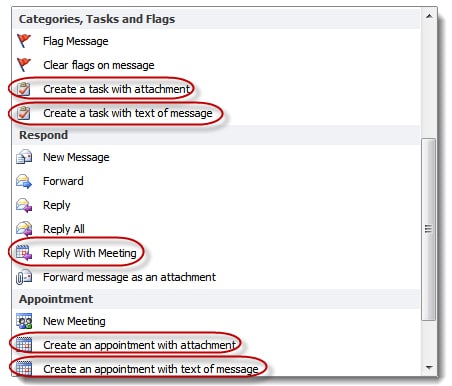If you’re using one of the Ribbon versions of Microsoft Outlook, you’ve probably overlooked one feature right on the Home tab: Quick Steps. Quick Steps are like macros — they string together several actions and make them all accessible with one click. The pre-installed Quick Steps only hint at the feature’s time-saving potential. Here are five ways to deploy Quick Steps today to manage your email better.
Unless otherwise noted, all instructions and screenshots are for Microsoft Office 2010 for Windows.
1. Pre-configured emails
Communicating with some recipients isn’t as easy as opening up a new email, popping in an email address (careful with that AutoComplete!) and typing a message. Some of them (e.g., insurance companies) require certain information in the subject line or body of every email (like a claim number), or require you to copy additional recipients. You could dread communicating with these people, or you could set up a Quick Step that fills all this information into a brand-new, ready-to-go email.
Just click Create New in the Quick Steps area of the Home tab, name your new Quick-Step (step 1 in the screenshot below) then choose New Email (step 2). Address the email (steps 3 and 4), type in your Subject line and any standard text you need (step 5), and, if you prefer keyboard shortcuts rather than mouse clicks, choose an optional shortcut key (step 6):
Next time you send that claims rep an email, you don’t have to look up the claim number or the cc: information. Just click the shortcut key you have selected once and start typing!
2. Clean your inbox
If you’re looking to achieve Inbox Zero, one pre-installed Quick Steps comes in really handy: Reply & Delete. It works like it sounds: It starts a reply email and deletes the original from your inbox. If you’re not comfortable with the “delete” step, right-click on Reply & Delete and choose Edit to either remove the Delete action or modify it to Move to Folder.
3. Forward to someone for handling
If you get a lot of electronic filing notices, particularly from court systems that don’t copy your assistant or paralegal, make a Quick Step to forward those along. Start the process like the pre-configured emails shown above, except your first action will be to forward the email either as is or as an attachment (useful for sending several at a time). Add some boilerplate text (“Download and file this”) if you like. You can even add a Flag for the recipient to pop up a reminder in their Outlook. Want to add a decluttering step? Click Add Action near the bottom of the dialog box and choose either Delete or Move to Folder. Next time you get an ECF filing, click that Quick-Step and consider it handled.
4. One-click filing
Lucky enough to have a document management system that interfaces with Outlook? Use Quick Steps to enable one-click filing. Some document management systems allow you to drag-and-drop emails out of your inbox into another folder, which in turn will automatically upload and index the email according to parameters you configure. Set up those folders for your busiest cases, then create a Quick Step to mark selected emails as read and move them into that folder.
5. Turn emails into tasks or appointments
A lot of emails are about actions you need to take (or assign), places you need to go or phone calls you need to initiate or receive. Why not take the information in that email, turn it into a to-do list item or appointment, and get it out of your inbox? By now, you know the drill — click Create New to start a new Quick Step and choose your first Action.
Again, you can click Add Action near the bottom of the dialog box and choose either Delete or Move to Folder to get one email closer to Inbox Zero with a single mouse click.
Don’t limit yourself to these five Quick Steps! Think about what you do in your inbox every day to see what other multi-step processes could become one-click wonders.




















